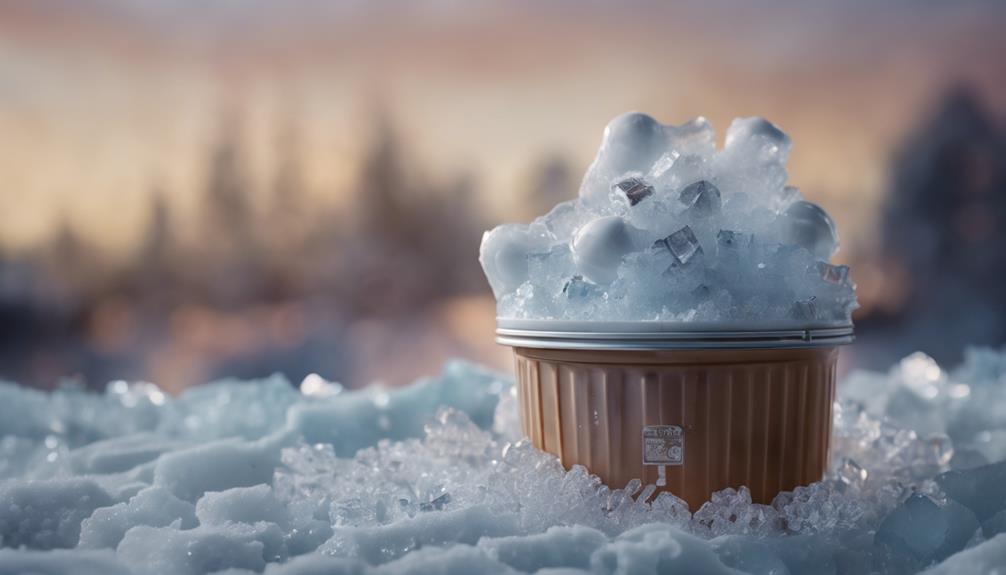To determine if ice cream has been refrozen, observe for any alterations. Watch out for a firmer, smaller texture. Take note of any graininess or crystals. Check for stickiness or frost. Be wary of potentially unsafe temperature shifts. For additional safety guidelines regarding ice cream, continue to examine the indicators outlined above.
Key Takeaways
- Check for firmer and smaller appearance.
- Note any grainy and crystallized consistency.
- Inspect for signs of stickiness or frost.
- Be wary of unsafe temperature fluctuations.
- Consider vegan alternatives for safe consumption.
Identifying Safe Refreezing Practices

To identify safe refreezing practices for ice cream, look for changes in texture and appearance that indicate potential risks. When it comes to food storage, a key indicator that ice cream has been refrozen is a firmer and smaller appearance caused by lost air bubbles.
Additionally, pay attention to any texture changes such as a grainy and crystallized consistency, as this is a sign that the ice cream may not be safe to eat.
Inspect the container for any signs of stickiness or frost, which could suggest that the ice cream has melted and refrozen.
It's essential to be wary of these visual cues as they can help you determine whether the ice cream has been subjected to unsafe temperature fluctuations.
Handling Perishable Ice Cream Items

When handling perishable ice cream items, make certain you keep them stored at the proper temperature to maintain their freshness and safety.
Here are some tips to make certain you handle perishable ice cream items correctly:
- Keep it Cold: Always store ice cream in the freezer at 0°F (-18°C) or below to prevent melting and bacterial growth.
- Avoid Temperature Fluctuations: Put the ice cream in the coldest part of the freezer to maintain its texture and flavor.
- Prevent Contamination: When putting the ice cream back in the freezer, ensure the container is tightly sealed to avoid absorbing odors from other foods.
- Handle with Care: Refrain from letting the ice cream sit out at room temperature for too long; put it back in the freezer promptly after serving to maintain its quality.
Understanding Ice Cream Shelf Life

When it comes to ice cream, understanding its shelf life is essential. Knowing that ice cream can last around 2 to 4 months in the freezer before quality begins to diminish is important.
Additionally, being aware of how refreezing can impact its texture and taste is key to enjoying a delightful frozen treat.
Shelf Life Considerations
Understanding the shelf life of ice cream is vital for ensuring its freshness and quality. Here are some key considerations to keep in mind:
- Ice cream should be consumed within a month of purchase to maintain freshness and best quality.
- Proper storage at temperatures between -5°F and 0°F is essential for preserving ice cream's quality and texture.
- Fluctuating freezer temperatures can have a negative impact on the taste and texture of ice cream over time.
- Soft ice cream may indicate improper storage or repeated softening and re-freezing, which can greatly affect its overall quality.
Quality After Refreezing
Properly storing ice cream is essential for maintaining its quality, especially when considering its shelf life after refreezing. When ice cream undergoes the process of refreezing, it may experience changes that affect its texture and appearance.
The ice cream could develop a grainy consistency with a smaller volume, primarily due to the loss of air bubbles during the initial freezing and subsequent thawing. Additionally, ice crystals may form, causing a frosty, sticky layer on the container.
While refrozen ice cream may not be as visually appealing or have the same texture as freshly bought ice cream, it's generally safe to eat if it has been stored correctly. However, to make sure of the best quality and taste, it's recommended to consume ice cream within a month of purchase.
Expert Advice on Food Safety

For thorough expert advice on food safety, contact UGA Family and Consumer Sciences Extension.
Here are some key tips to keep in mind:
- Check Food Labels: Always inspect the expiration dates and storage instructions on items purchased at the grocery store.
- Proper Storage: Store perishable items like meat and dairy in the refrigerator within two hours of purchase to prevent bacteria growth.
- Safe Thawing: Thaw frozen foods in the refrigerator, under cold water, or in the microwave to guarantee even thawing and prevent bacterial growth.
- Cooking Temperatures: Use a food thermometer to make certain that meat, poultry, and seafood reach safe internal temperatures to kill harmful bacteria.
Causes of Ice Cream Contamination

Ice cream can become contaminated with harmful bacteria such as Listeria during various stages from production to consumption. Contamination of ice creams can happen during manufacturing, shipment, or even from unsafe ingredients.
Ingredients like eggs in ice cream can carry Salmonella, while milk and cream may harbor bacteria like Salmonella, E. coli, and Listeria. The use of unpasteurized eggs or improper heat treatment of final ice cream products can result in foodborne illnesses.
Throughout the process, from production to consumption, there are multiple opportunities for contamination to occur, heightening the risk of food poisoning. Refreezing melted ice cream doesn't eliminate existing bacteria, underscoring the significance of proper handling to prevent contamination.
Being vigilant about the sources and handling of ingredients in ice cream production is essential to guarantee the safety of the final product for consumers.
Vulnerability to Bacteria

Vulnerability to bacteria in ice cream arises due to the potential contamination of common ingredients like eggs, milk, and cream during various stages of production and consumption.
To maintain safety, it's vital to be aware of the following:
- Salmonella Risk: Ice cream containing eggs poses a risk of Salmonella bacteria, which can lead to foodborne illness.
- Contamination Susceptibility: Milk and cream used in ice cream are prone to bacteria like Salmonella, E. coli, and Listeria.
- Unpasteurized Ingredients: Using unpasteurized eggs or ingredients can introduce harmful bacteria into ice cream products.
- Heat Treatment Importance: Proper heat treatment during ice cream production is crucial to eliminate pathogenic bacteria.
Contamination risks exist from manufacturing to consumption, highlighting the significance of proper handling practices to minimize the risk of bacterial infections from ice cream consumption.
Symptoms of Food Poisoning

If you consume ice cream that has been refrozen and suspect food poisoning, watch out for symptoms like fever, diarrhea, and abdominal cramps.
These signs usually show up 12 to 72 hours after eating contaminated ice cream.
Seek medical help, especially if you're at a higher risk or notice worsening symptoms.
Symptoms of Contamination
Symptoms of contamination from refrozen ice cream, such as fever, diarrhea, and abdominal cramps, typically manifest within 12 to 72 hours after consumption. If you suspect you may have consumed contaminated ice cream, watch out for the following signs:
- Fever: An elevated body temperature is a common symptom of ice cream contamination.
- Diarrhea: Keep an eye out for frequent loose or watery stools, as this could indicate food poisoning.
- Abdominal Cramps: Cramping in the stomach area is a typical indicator of gastrointestinal distress.
- Nausea or Vomiting: Feeling queasy or experiencing vomiting after consuming ice cream could point to contamination.
Onset Timing Post-Contamination
After consuming refrozen ice cream, you can expect symptoms of food poisoning to appear within a timeframe of 12 to 72 hours. This post-contamination period is pivotal as it marks the onset of potential illness due to consuming contaminated ice cream.
Common signs of ice cream-related food poisoning include fever, diarrhea, and abdominal cramps. These symptoms typically last for about four to seven days on average.
It's noteworthy that individuals with weakened immune systems or those at higher risk should promptly seek medical attention if they suspect ice cream-related illness.
While many cases of ice cream food poisoning resolve on their own, worsening symptoms such as persistent fever or severe dehydration shouldn't be overlooked.
Monitoring your health post-contamination is essential, and seeking medical care if symptoms escalate ensures timely and appropriate treatment for ice cream-related food poisoning.
Seek Medical Attention
Wondering when it's essential to seek medical attention for food poisoning symptoms after consuming refrozen ice cream? If you start experiencing symptoms like fever, diarrhea, and abdominal cramps after eating refrozen ice cream, it's crucial to consider seeking medical attention.
The onset of food poisoning symptoms usually occurs within 12 to 72 hours after contamination, and the average duration of infection ranges from four to seven days.
Individuals with compromised immune systems or those at high risk should be especially vigilant and consult a healthcare provider if their symptoms worsen after consuming refrozen ice cream. While many cases of food poisoning resolve on their own, it's important to prioritize your health and seek medical attention if the symptoms persist or become more severe.
- Fever, Diarrhea, and Abdominal Cramps: Look out for these common symptoms of food poisoning.
- Onset Timing: Symptoms usually appear within 12 to 72 hours post-contamination.
- Duration of Infection: Infections from ice cream can last from four to seven days.
- High-Risk Individuals: Those with compromised immune systems should seek medical care if symptoms worsen.
Preventative Measures

To prevent bacterial growth and ensure the safety of your ice cream, follow these preventive measures. When handling ice cream, make sure that utensils used for scooping are clean to prevent any potential contamination. Avoid refreezing ice cream that has completely melted, as this can lead to the growth of harmful bacteria.
If you notice that ice cream has been left out at room temperature for an extended period, it's best to discard it to avoid any risks. Keeping ice cream frozen at all times is vital to maintaining its quality and safety.
Additionally, when selecting ice cream products, opt for those without unpasteurized ingredients to lower the chances of foodborne illnesses. By following these simple steps, you can enjoy your ice cream without worrying about potential health hazards. Remember, prevention is key when it comes to keeping your frozen treats safe to eat.
Detecting Refrozen Ice Cream

Detecting refrozen ice cream can be done by observing changes in its appearance and texture. When checking for signs of refreezing, keep an eye out for the following:
- Firmer and Smaller Appearance: Refrozen ice cream may look denser and shrink in size due to the loss of air bubbles during the melting and refreezing process.
- Grainy and Crystallized Texture: The texture of refrozen ice cream can become gritty and less smooth, impacting the overall quality and mouthfeel of the dessert.
- Sticky and Frosted Container: A container that appears sticky and frosted could indicate that the ice cream has previously melted and refrozen.
- Consider Vegan Alternatives: Vegan nice cream, made from frozen fruits like bananas, offers a safer option without the risk of refreezing concerns associated with dairy ice cream.
Frequently Asked Questions
How to Tell if Refrozen Ice Cream Is Bad?
If ice cream has been refrozen, check for a firmer texture, smaller size, and grainy consistency. The container may be sticky and frosted. When in doubt, consider vegan nice cream as a safer alternative.
Is It Safe to Eat Ice Cream That Has Been Defrosted and Refrozen?
Eating ice cream that has been defrosted and refrozen isn't safe due to the risk of harmful bacteria growth. It can lead to foodborne illness. Avoid refrozen ice cream for your health's sake.
How to Tell if Ice Cream Has Been Tampered With?
To tell if ice cream has been tampered with, check for signs like a smaller size, firmer texture, or crystallization. Look for frost or stickiness on the lid, grainy or icy consistency in the ice cream, and opt for vegan nice cream if unsure.
What Is the Texture of Refrozen Ice Cream?
When ice cream is refrozen, its texture changes to grainy and crystallized. You'll notice it feels firmer and smaller, with lost air bubbles. The container might even feel sticky and frosted from melted ice cream.
Is it safe to refreeze ice cream if it has been thawed?
It is not safe to refreeze ice cream if it has been thawed. When ice cream thaws, the texture changes and it becomes prone to bacterial growth. This can lead to foodborne illness. That’s why magnum ice cream costly – because it contains high-quality ingredients and is carefully produced to ensure safety and quality.
Conclusion
So there you have it, folks! Remember, if your ice cream looks like a science experiment gone wrong, chances are it's been refrozen.
Stay safe and keep those frozen treats fresh!
And hey, if all else fails, just eat it straight from the carton – who's time to worry about refreezing when there's delicious ice cream to be devoured?
Enjoy!
















